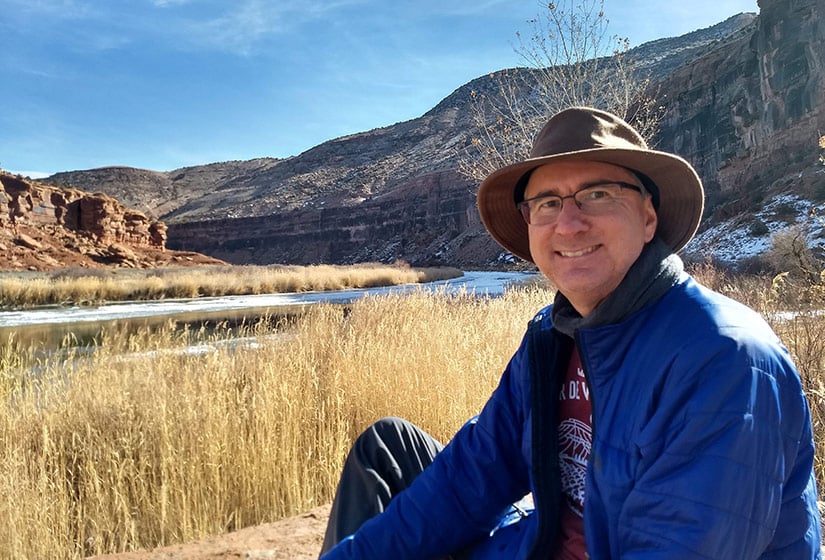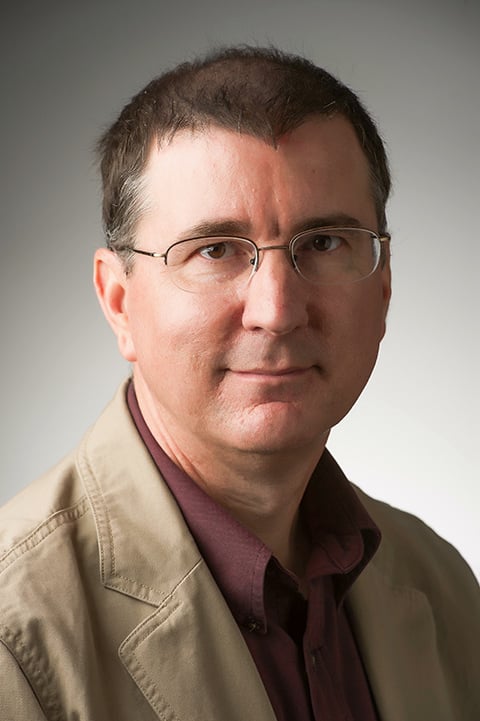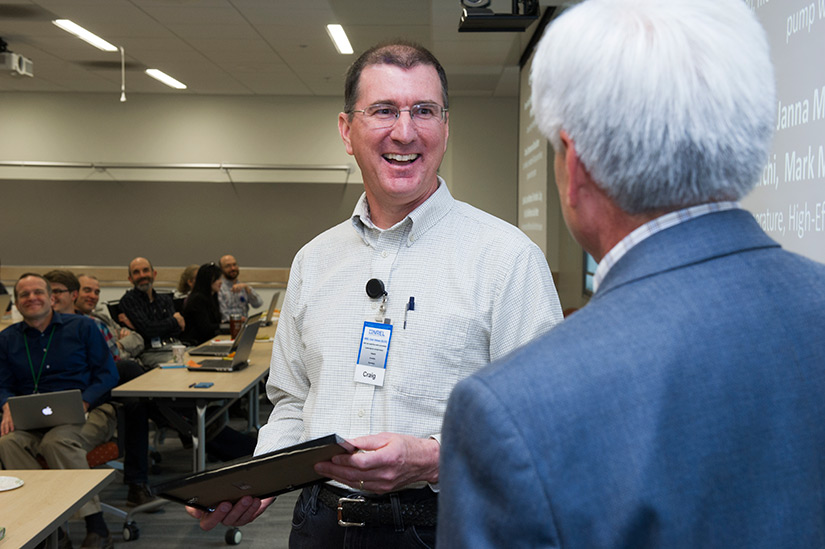NREL Researcher Craig Turchi Brings Small Business Experience to Big Concentrating Solar Projects
Turchi’s Years at a Tech Startup Gave Him a Savvy Outlook on Concentrating Solar Power (CSP) Systems Analysis and Innovation

Honesty is the best policy, and from his early days at the National Renewable Energy Laboratory (NREL), Craig Turchi embraced that policy in his work as a chemical engineer in concentrating solar power (CSP).
In fact, fresh out of his Ph.D. program and working at his first job, he was not afraid to tell the U.S. Department of Energy the truth about a solar detoxification reactor his team was working on: Based on the reaction rates he had modeled, it was not going to work—at least, not as currently planned.
It was his first CSP project at the laboratory in the early 1990s, when NREL was called the Solar Energy Research Institute (SERI). The reactors used sunlight concentrated from parabolic mirrors into fluid-filled tubes to break down contaminants in water, using titanium dioxide as a catalyst. Concentrating the sunlight sped up reaction rates, but for this chemistry, it also reduced the reaction efficiency. Turchi knew the efficiency results meant the cost would not add up. The team pivoted.
“We followed the science,” he said. “You’re initially pursuing things based on hope in many cases, but when the data come in, you have to follow the science.”
This first research result at SERI earned him a reputation as a straight shooter that stayed with him for 35 years as he built a career in CSP and thermal energy science.
“That scientific integrity is something everyone looks up to,” said Guangdong Zhu, CSP subprogram lead at NREL and Thermal and Hybrid Energy Systems group manager. “As researchers, we should focus on simply assessing the results based on scientific justification. For Craig, this comes naturally. His evaluation is never going to be influenced by any other factors.”
Turchi now serves as the Thermal Energy Science and Technologies group manager in NREL’s Energy Conversion and Storage Systems (ECaSS) Center, and he led NREL’s CSP subprogram from 2022 until 2024, when he passed the baton to Zhu. He also serves as the partnership director for the Heliostat Consortium, a U.S. Department of Energy consortium led by NREL and Sandia National Laboratories in partnership with the Australian Solar Thermal Research Institute.
His leadership extends beyond his work at the laboratory. An avid outdoorsman, Turchi is known around NREL for leading paddling trips on Colorado’s and Utah’s scenic rivers. He and his wife, Jeannette, along with their daughter also help run a food bank at their church through Food Bank of the Rockies, where they serve 150–200 people once a month.
“I find that very fulfilling, and it’s a nice counterpoint to writing reports at a computer to go out and physically do something and see the immediate benefit happening in your community,” he said. “I think it’s very important to give back.”
Bringing Small Business Experience to Systems Analysis Research

Turchi started working at SERI in 1990 but left in 1996 for a position with a startup that did not fully launch. He then joined a small company called ADA Technologies, where he served as a principal investigator and program leader for 10 years.
At ADA, Turchi obtained his first patents. He was particularly proud of a product he created to separate amalgam for dental offices. At the time, when dentists placed or removed silver fillings, which are nominally 50% mercury, tiny bits of the filling would get suctioned out and end up in city sewer systems—where the mercury could eventually be released. His system trapped the amalgam bits at the dental office for recycling, keeping mercury from accumulating to harmful levels in bays and estuaries.
Upon his return to NREL in 2008, he found that his time in the startup world translated well at the laboratory. He had honed his proposal-writing skills when working at ADA. He also brought new experiences when he returned, including an eye for innovation and a keen business sensibility. That outlook, paired with his truth-seeking ethos as an engineer, helped him build a robust research program in CSP systems analysis. The program allowed NREL to fill a niche that had been missing in the industry.
“NREL started doing a lot of systems analysis,” said Mark Mehos, an emeritus NREL researcher who hired Turchi back to NREL in 2008. “And the U.S. Department of Energy really appreciated the robustness of Craig’s analysis. He was very thorough, he was very honest, and he didn’t hold back. If the analysis seemed to show that this was the right path or the wrong path, Craig didn’t have any qualms about sharing that.”
CSP is a flexible technology. It can be used to generate electricity, create thermal energy for long-duration energy storage, or create thermal energy for a range of industrial processes that require heat, such as those used in food processing or desalination. That flexibility means there are a lot of factors to consider when analyzing costs, and making an honest assessment is crucial. As early-career researchers joined Turchi’s team, they learned from his rigorous approach to research and analysis.
“He's the real CSP guru—Craig keeps things grounded with his practical mindset,” said Judith Vidal, Building Thermal Energy Science group manager. Vidal got her start at NREL as a postdoc for Turchi in CSP. “His advice stuck with me: Always approach things with economic sensibility.”
Vidal’s research emphasis is no longer in CSP, but those lessons still apply.
“Since many of our projects are applied research, you always have to keep cost-effectiveness in mind,” she said. “But I also learned from him that sometimes, simply saying ‘This is too expensive’ pushes you to think differently in the lab—to optimize, to explore new directions. It challenges you. This is how Craig shaped me as a young researcher.”

Applying a New Power Cycle to CSP
In addition to his main body of work in systems analysis and related topics, Turchi was looking for brand-new areas of research when he returned to NREL. A power cycle that was becoming popular in nuclear energy circles, but not solar, caught his attention: the supercritical carbon dioxide (CO2) power cycle.
“There was a renaissance in this power cycle development after a study came out that showed it could be valuable at nuclear power plants,” Turchi said. “It’s a type of power cycle development that had been looked at decades ago, and it kind of got stuck on a back shelf. No one really looked at it.”
Turchi saw potential for supercritical CO2 power cycles to replace the steam turbines in traditional CSP systems, potentially unlocking greater efficiencies.
This initial curiosity about supercritical CO2 for CSP has grown into a major path forward for the CSP industry—Generation 3 CSP. In Gen 3 CSP, arrays of mirrors called heliostats concentrate sunlight onto a central receiver to collect and store heat at high temperature (over 700°C). This heat is transferred to supercritical CO2 to generate power in a closed-loop Brayton cycle. Sandia National Laboratories now has a Gen 3 Particle Pilot Plant at its National Solar Thermal Test Facility to study supercritical CO2 as the working fluid in a plant with particle energy storage.
Turchi won two NREL awards for his work on the supercritical CO2 power cycle for CSP. But nowadays, he is more focused on elevating other researchers’ work.
“As you progress in your career, you either remain an expert in some area, or in my experience, you broaden out into what the interesting areas are in your field, and you help others develop,” Turchi said. “I think as a group manager, that’s your role. It’s very rewarding when you see those people succeed.”
Learn more about NREL’s concentrating solar power research.
Last Updated May 28, 2025
